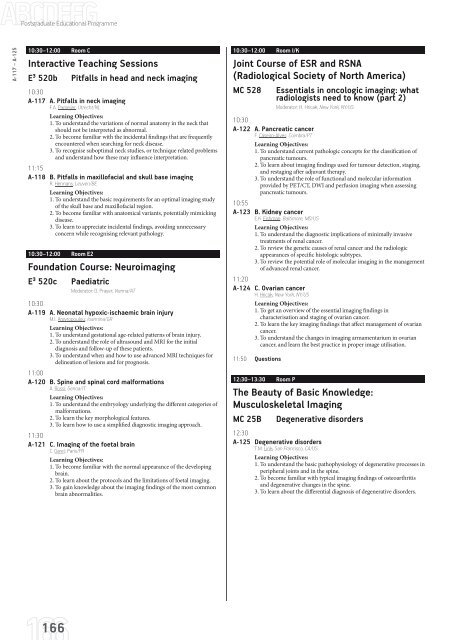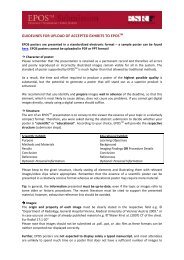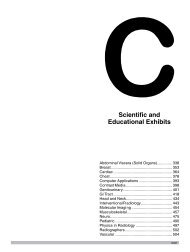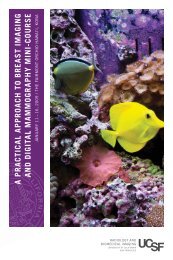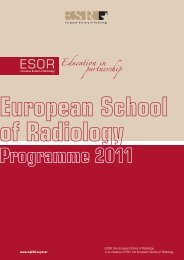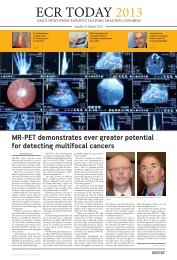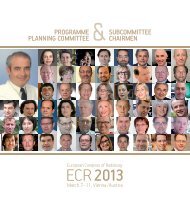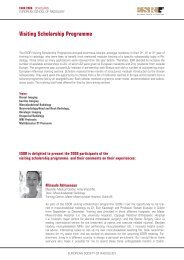ECR 2013 â Final Programme - myESR.org
ECR 2013 â Final Programme - myESR.org
ECR 2013 â Final Programme - myESR.org
- No tags were found...
Create successful ePaper yourself
Turn your PDF publications into a flip-book with our unique Google optimized e-Paper software.
Postgraduate Educational <strong>Programme</strong>A-117 – A-12510:30–12:00 Room CInteractive Teaching SessionsE³ 520b Pitfalls in head and neck imaging10:30A-117 A. Pitfalls in neck imagingF.A. Pameijer; Utrecht/NLLearning Objectives:1. To understand the variations of normal anatomy in the neck thatshould not be interpreted as abnormal.2. To become familiar with the incidental findings that are frequentlyencountered when searching for neck disease.3. To recognise suboptimal neck studies, or technique related problemsand understand how these may influence interpretation.11:15A-118 B. Pitfalls in maxillofacial and skull base imagingR. Hermans; Leuven/BELearning Objectives:1. To understand the basic requirements for an optimal imaging studyof the skull base and maxillofacial region.2. To become familiar with anatomical variants, potentially mimickingdisease.3. To learn to appreciate incidental findings, avoiding unnecessaryconcern while recognising relevant pathology.10:30–12:00 Room E2Foundation Course: NeuroimagingE³ 520c PaediatricModerator: D. Prayer; Vienna/AT10:30A-119 A. Neonatal hypoxic-ischaemic brain injuryM.I. Argyropoulou; Ioannina/GRLearning Objectives:1. To understand gestational age-related patterns of brain injury.2. To understand the role of ultrasound and MRI for the initialdiagnosis and follow-up of these patients.3. To understand when and how to use advanced MRI techniques fordelineation of lesions and for prognosis.11:00A-120 B. Spine and spinal cord malformationsA. Rossi; Genoa/ITLearning Objectives:1. To understand the embryology underlying the different categories ofmalformations.2. To learn the key morphological features.3. To learn how to use a simplified diagnostic imaging approach.11:30A-121 C. Imaging of the foetal brainC. Garel; Paris/FRLearning Objectives:1. To become familiar with the normal appearance of the developingbrain.2. To learn about the protocols and the limitations of foetal imaging.3. To gain knowledge about the imaging findings of the most commonbrain abnormalities.10:30–12:00 Room I/KJoint Course of ESR and RSNA(Radiological Society of North America)MC 528 Essentials in oncologic imaging: whatradiologists need to know (part 2)Moderator: H. Hricak; New York, NY/US10:30A-122 A. Pancreatic cancerF. Caseiro-Alves; Coimbra/PTLearning Objectives:1. To understand current pathologic concepts for the classification ofpancreatic tumours.2. To learn about imaging findings used for tumour detection, staging,and restaging after adjuvant therapy.3. To understand the role of functional and molecular informationprovided by PET/CT, DWI and perfusion imaging when assessingpancreatic tumours.10:55A-123 B. Kidney cancerE.K. Fishman; Baltimore, MD/USLearning Objectives:1. To understand the diagnostic implications of minimally invasivetreatments of renal cancer.2. To review the genetic causes of renal cancer and the radiologicappearances of specific histologic subtypes.3. To review the potential role of molecular imaging in the managementof advanced renal cancer.11:20A-124 C. Ovarian cancerH. Hricak; New York, NY/USLearning Objectives:1. To get an overview of the essential imaging findings incharacterisation and staging of ovarian cancer.2. To learn the key imaging findings that affect management of ovariancancer.3. To understand the changes in imaging armamentarium in ovariancancer, and learn the best practice in proper image utilisation.11:50 Questions12:30–13:30 Room PThe Beauty of Basic Knowledge:Musculoskeletal ImagingMC 25B Degenerative disorders12:30A-125 Degenerative disordersT.M. Link; San Francisco, CA/USLearning Objectives:1. To understand the basic pathophysiology of degenerative processes inperipheral joints and in the spine.2. To become familiar with typical imaging findings of osteoarthritisand degenerative changes in the spine.3. To learn about the differential diagnosis of degenerative disorders.166


